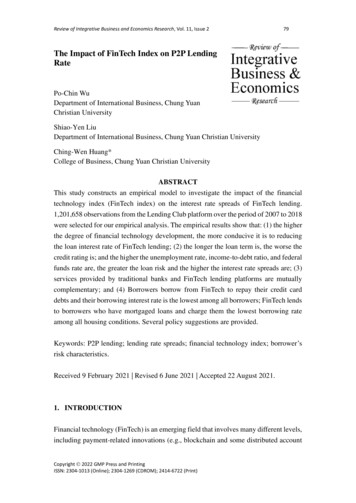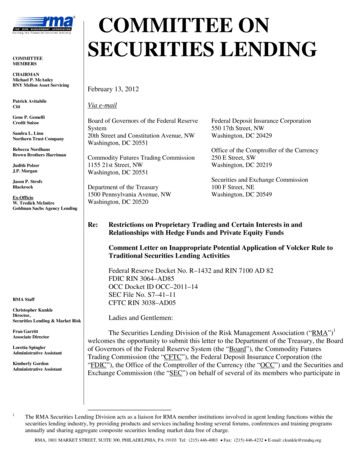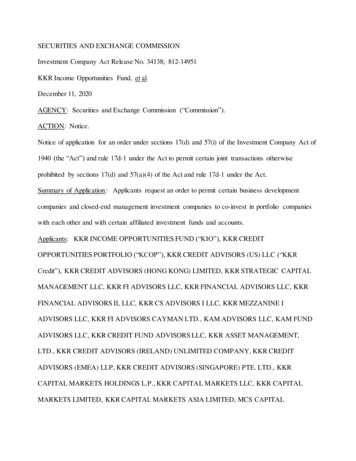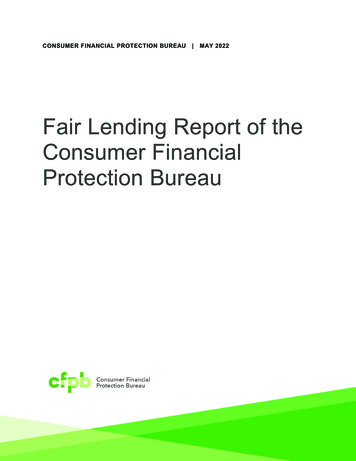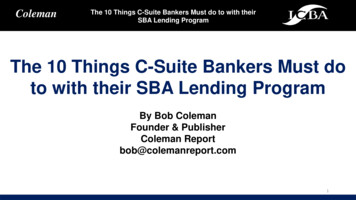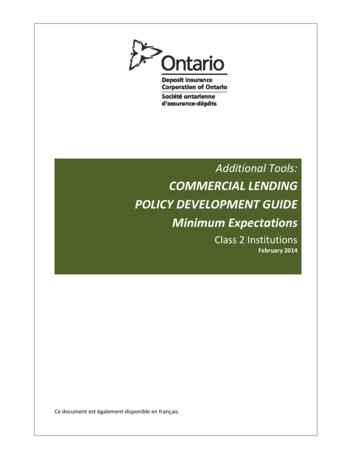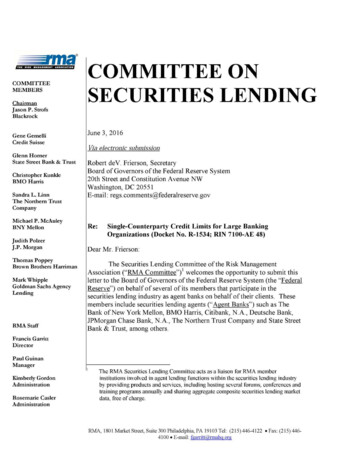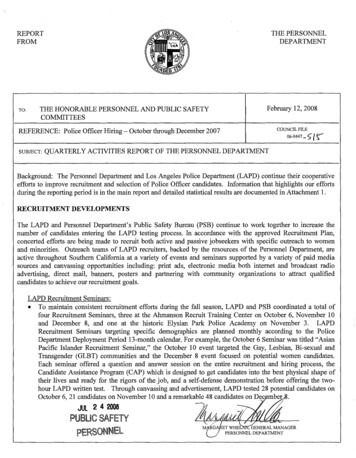
Transcription
Fair Lending Implicationsof Credit Scoring Systemsuring the past decade, lenders’use of credit scoring systemshas increased significantly, andexaminers routinely consider the roleof credit scores in lending decisions.The comparative analysis portion ofa fair lending examination includesan interview to determine the criteriathe lender considered in the decisionpoint (underwriting, pricing, etc.)selected for review.1 This interview frequently reveals that a credit score wasone of the criteria. At this point, examiners can determine how to proceed byconsulting the Interagency Fair LendingExamination Procedures.2 However,examiners must synthesize informationfrom several sections of the Proceduresand the appendixes.DThis article gives examiners the toolsthey will need to navigate this situation.It provides an overview of credit scoringsystems, analyzes why the use of creditscores has proliferated, and explainshow their use is considered as part of afair lending examination. It then recommends a concise conceptual frameworkfor proceeding with a fair lending examination when a credit score is one of thecriteria considered by the lender.An Overview of CreditScoring SystemsA credit scoring system mechanicallyevaluates creditworthiness on the basisof key attributes of the applicant andaspects of the transaction.3 A systemcan be as simple as a form the loanofficer completes by hand that assignspoints to particular attributes, or ascomplex as an artificial intelligencebased neural network with a continuousfeedback loop that adjusts the weightingcoefficients and the cutoff score. Acredit scoring system can be the onlyfactor considered in making the creditdecision, or the lender may combinea credit score with other criteria.4Two types of credit scores exist—bureau scores and custom scores. Abureau score considers only the information on an individual’s credit reportand is generated by a consumer reporting agency. The largest three consumerreporting agencies are Experian,Equifax, and TransUnion. A lenderpays the consumer reporting agency anadditional fee to obtain the score at thetime it obtains a copy of the creditreport. An “acceptable” score varieswith the lender’s appetite for risk;however, an acceptable score usuallyfalls around 600.A custom score (sometimes referredto as an application score) is generatedby the lender from a scoring systemeither developed by the lender orpurchased from a vendor. A customscore usually considers the information on the applicant’s credit report,selected information about the applicant, and characteristics of the credittransaction. Examples of commonlyconsidered applicant information aretype of residence, length of time at1FDIC-regulated institutions are subject to two Federal statutes that prohibit discrimination in lending. The EqualCredit Opportunity Act (ECOA) covers all credit transactions. It prohibits discrimination on nine bases—race, color,religion, sex, national origin, age, marital status, receipt of public assistance, and the exercise of a right under theConsumer Credit Protection Act. The regulation that implements ECOA is 12 C.F.R., Part 202 (Regulation B). The FairHousing Act covers residential real estate-related credit transactions. It prohibits discrimination on seven bases—race, color, religion, sex, national origin, handicap, and familial status. The regulation that implements the FairHousing Act is 24 C.F.R., Part 100.2Interagency Fair Lending Examination Procedures, www.fdic.gov/consumers/community/fairlend.pdf312 C.F.R. 202.2(p)(1).4Official Staff Interpretations at Paragraph 202.6(b)(2), Comment 5.23Supervisory InsightsSummer 2005
Fair Lendingcontinued from pg. 23current residence, type of employment,length of time in current employment,and income. Typically, eight to tenvariables are considered in a customscorecard. Many custom scoring systemsare scaled so that an acceptable scorewill be around 200, again dependingon the lender’s risk appetite. The scaling of custom credit scoring systemsvaries considerably among vendorsand lenders. Some lenders blend anapplicant’s bureau score and a customscore in making a credit decision.The Use of Credit ScoringSystems Has IncreasedConsiderablyThe accuracy and cost of credit scoringsystems have benefited substantially fromtechnological advances in automateddata processing and improvements instatistical methodologies. Many lendershave found that credit scoring systemsare cutting the time and administrativecosts of making credit decisions, aswell as improving the consistency ofthe decisions within their organizations.As a result: More lenders are using credit scoringsystems. Lenders are applying credit scoringsystems to more credit products. Lenders are using credit scoringsystems in additional aspects ofcredit transactions, such as pricingand account administration. Lenders are using multiple systemsin a single credit product.5The increased use of credit scoringsystems has implications for examiners asthey conduct fair lending examinations.The Role of Credit ScoringSystems in a Fair LendingExaminationA fair lending examination attemptsto detect either overt discriminationor disparate treatment on a prohibitedbasis. Examiners select a focal pointbased on the risk that discriminationmay be occurring, determine the criteria the lender considers in making thecredit decision, evaluate the criteria andprocedures for overt discrimination, andcompare how the criteria are applied toa selected prohibited basis group withhow they are applied to an appropriatecontrol group. For example, the treatment of Hispanic applicants may becompared with the treatment of nonHispanic whites.6The use of a fairly developed andapplied credit scoring system can reducethe possibility of unlawful discriminationby helping to ensure consistency anduniformity and minimizing individualjudgment and discretion. However, acredit scoring system is not a panacea,and in certain circumstances, it caneven be the source of fair lendingviolations.Disparate treatment can occur atthree stages in the use of a customcredit scoring system: Data development and input: Forexample, a lender credits whiteapplicants with the length of timethey have worked in the same fieldbut credits Hispanic applicants onlywith the length of time they haveworked for their present employer.Or, a lender credits white applicantswith secondary income (such asbonuses, overtime, or commissions)5Many lenders segment the applicant population by applicant characteristics, channels through which the application was received, or both. For example, a lender may have one system for applicants with nothing worse thana 30-day late on their credit report and a different system for applicants with more serious derogatory information.Or, a lender may have one system for automobile loan applications received directly from the borrower and adifferent system for automobile loan applications received indirectly through an auto dealer.6See footnote 2.24Supervisory InsightsSummer 2005
but credits Hispanic applicants onlywith base salary. In either example,because discriminatory data areinput into the system, the systemwill produce a discriminatory result. Within the credit scoring system:The system could include a prohibited basis as one of the variables,or, if not a prohibited basis itself,a factor that is so highly correlatedwith a prohibited basis that itserves as a proxy for the basis.(As discussed later in this article,in certain circumstances age canbe considered in a credit scoringsystem.) A variable that considersthe geographic area in which anapplicant lives should be carefullyscrutinized to determine if thegeographic distinctions are sohighly correlated with a prohibitedbasis that they serve as a proxy forthat basis. In 2001, the Departmentof Justice (DOJ) settled a caseagainst Associates National Bankin which the bank required a highercutoff score for applicants whoapplied on Spanish-language applications than it required of applicantswho applied on English-languageapplications.7 DOJ treated theSpanish-language application as aproxy for ethnicity.8 Discretionary overrides: The morediscretion bank staff is permitted inoverriding a credit scoring system,and the greater the number of staffwith override authority, the greaterthe risk that the discretion will beexercised discriminatorily. Discretionary overrides fall into two categories. Low-side overrides aredecisions to approve an applicantwhose credit score falls below thecutoff score, and high-side overridesare decisions to deny an applicantwhose credit score exceeds the cutoff score. The two types of overridesshould be independently analyzedto detect an overall pattern ofdisparate treatment. This type ofviolation is illustrated by a settlement agreement between DOJ andDeposit Guaranty National Bankin 1999. The bank used a customscorecard to underwrite applications for home improvement loans,but gave broad discretion to loanofficers to override the creditscoring system. The pattern ofoverrides showed that white applicants were significantly more likelythan black applicants to be approvedwith a credit score below the cutoff,and black applicants were significantly more likely than white applicants to be denied with a creditscore above the cutoff.9How should a fair lending examination be conducted once an examinerlearns that a credit score is one ofthe criteria used in making a creditdecision? Initially, the examiner shoulddetermine if the credit score is a bureauscore or a custom score. If it is a bureauscore, the examiner does not need toobtain more information about the scoring system. The comparative analysisshould focus on the pattern of overridesand the lender’s consideration of othercriteria unrelated to the system. It israre for a bureau score to be the onlycriterion considered in making a creditdecision.However, if the credit score is a customscore, the examiner should obtain a list7United States v. Associates National Bank (D. Del.), e opportunity for overt discrimination or disparate treatment to occur does not exist in the first two stagesif the lender uses a bureau score, because (1) the lender does not develop or input the data and (2) we canconfirm from publicly available information that bureau scores do not consider any prohibited basis, includingage, or any variable that could be considered a proxy for a prohibited basis.9United States v. Deposit Guaranty National Bank (N.D. Miss.). upervisory InsightsSummer 2005
Fair Lendingcontinued from pg. 25of the variables considered by the systemand determine if the scoring system issplit into multiple cards on the basis ofage. If a prohibited basis other than age,or a possible proxy for a prohibited basisother than age, is contained in the variables, the examiner should report thisinformation to his or her manager assoon as possible. Addressing the overtdiscrimination issue will consume significant resources; therefore, the examinershould also consult with the managerabout whether to continue with theplanned comparative analysis.As mentioned previously, age is theonly prohibited basis that legally canbe considered in a credit scoringsystem. Age is not a prohibited basisunder the Fair Housing Act, and theEqual Credit Opportunity Act and Regulation B provide a narrow exception forthe consideration of age if the systemmeets certain requirements.It is preferable from a risk managementstandpoint for a lender to validate everycredit scoring system used to underwriteor price loans. However, from a compliance standpoint, a credit scoring systemdoes not have to be validated unless itconsiders age. A credit scoring systemcan consider age in one of two ways:(1) the system can be split into different scorecards depending on the age ofthe applicant or (2) age may be directlyscored as a variable. Some systems mayconsider age in both ways. Regulation Brequires that all credit scoring systemsthat consider age be validated. Theregulation uses the term “empiricallyderived, demonstrably and statisticallysound.”10 For purposes of this article,we will refer to this term as “valid.”10The burden is on the lender to demonstrate that a credit scoring system thatconsiders age is valid for each creditproduct for which it is being used. Aninitial validation and periodic revalidations must occur to allow the scoringsystem to consider age.11 Generally, alender must validate a credit scoringsystem based on data from the institution’s own through-the-door applicantpopulation. However, if the lender’s dataare insufficient for an initial validation,the lender is permitted to obtain a validated scoring system or the data fromwhich to develop a validated system fromanother lender or lenders for use on aninterim basis. A lender must validate andrevalidate its system based on its owndata when they become available.12Age-Split SystemsThe system is treated as considering,but not scoring, age if it is split into onlytwo cards, neither of which contains ageas a variable, and one card covers a wideage range that encompasses elderlyapplicants. (Elderly applicants are applicants 62 years of age or older.)13 Typically, the younger card in an age-splitsystem is used for applicants under aspecific age between 25 and 30. Theyounger scorecard de-emphasizes certainfactors, such as the number of accountson the applicant’s credit history, the ageof the oldest account on the applicant’scredit history, length of employment,and length of time at present residence,but increases the negative weight of anyderogatory information on the creditreport. Validation is the only requirement Regulation B imposes on a systemthat considers, but does not score, age.1412 C.F.R. 202.2(p) and Official Staff Interpretations.11A credit scoring system that considers age must be validated and revalidated even if it is only one of severalfactors considered in the credit decision. Official Staff Interpretations at Paragraph 202.6(b)(2), Comment 5.12Official Staff Interpretations at Paragraph 202.2(p), Comment 3.1312 C.F.R. 202.2(o).14Official Staff Interpretations at Paragraph 202.6(b)(2), Comment 2.26Supervisory InsightsSummer 2005
Conducting a Fair Lending Examination—A Conceptual Framework1.2.3.Determine if the credit score is a bureau score or a custom score.If the credit score is a bureau score, no further information about the system itself need be obtained. Complete the comparativeanalysis focusing on the pattern of low- and high-side overrides and the application of any other criteria.If the credit score is a custom score:a. Obtain a list of the variables considered in the credit scoring system and determine if the system is split on the basis of age.b. If a prohibited basis other than age, or a possible proxy for a prohibited basis other than age, is contained in the variables,report this information to your manager as soon as possible.c. If age is considered in the system, either through age-split scorecards, direct scoring of age, or both, obtain the lender’sdocumentation on the initial validation and all periodic revalidations, including weighting coefficients, and submit thedocumentation to the Washington Office for expert review.15d. Complete the comparative analysis, considering whether there are indications of disparate treatment in either the development and input of the applicant data, the low- and high-side overrides, or both.The FDIC has regional Fair Lending Examination Specialists available to provide technical assistance to FDIC examiners conductingany aspect of a fair lending examination.Systems that Score AgeA system is treated as scoring age if ageis directly scored as a variable, regardlessof whether the system is also age-split,or if elderly applicants are included in acard with a narrow age range in an agesplit system. Regulation B imposes asecond requirement on scoring systemsthat score age—the age of an elderlyapplicant must not be assigned a negativefactor or value.16The next steps in the fair lending examination framework flow from theserequirements. If a custom scoring systemconsiders age, the examiner shouldobtain the lender’s documentation onthe initial validation and all periodicrevalidations, including the weightingcoefficients. At the FDIC, the documentation is then submitted to the Washington Office through regional managementfor expert review. The examiner shouldthen complete the comparative analysisconsidering whether there are indications of disparate treatment in either thedevelopment and input of the applicantdata, low- and high-side overrides of thesystem, or both.In summary, based on an understanding of the different types of credit scoring systems and the Regulation Brequirements for scoring systems thatconsider age, the framework in theshaded box is recommended forconducting a fair lending comparativeanalysis of credit decisions in whichone of the criteria considered is acredit score.Benefits of Using ThisFrameworkThis conceptual framework is recommended as an aid in conducting efficient fair lending examinations thatresult in correct, legally supportable15This paragraph describes the procedures adopted by the Federal Deposit Insurance Corporation (FDIC). Examiners at other regulatory agencies should consult their agencies’ most recent guidance.16A negative factor or value means utilizing a factor, value, or weight that is less favorable than the lender’s experience warrants, or is less favorable than the factor, value, or weight assigned to the most favored age groupbelow the age of 62. (12 C.F.R. 202.2(v)).27Supervisory InsightsSummer 2005
Fair Lendingcontinued from pg. 27conclusions. Applying the frameworkdoes the following: Assists in focusing the review forovert discrimination and disparatetreatment only on those areas inwhich it possibly exists; Ensures that the requirementsof Regulation B for validationand treatment of the elderly areconsidered only for the smallminority of credit scoring systemsto which they apply; Ensures that lenders that choose touse custom credit scoring systemsthat consider age comply with therigorous requirements for the narrowexception to the general prohibitionagainst age discrimination; and Ensures that validation documentation is reviewed by FDIC staff withthe appropriate, highly specializedexpertise.R. Russell BaileySenior Fair Lending Specialist28Supervisory InsightsSummer 2005
cants to be denied with a credit score above the cutoff. 9 . How should a fair lending examina-tion be conducted once an examiner learns that a credit score is one of the criteria used in making a credit decision? Initially, the examiner should determine if the credit score is a bureau score or a custom score. If it is a bureau
